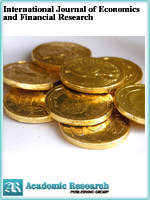International Journal of Economics and Financial Research
Online ISSN: 2411-9407
Print ISSN: 2413-8533
Print ISSN: 2413-8533
Quarterly Published (4 Issues Per Year)

Archives
Volume 1 Number 4 July 2015
A Multivariate Causal Relationship among Road Transport Infrastructure Development, Economic Growth and Poverty Level in Nigeria
Authors: Oladipo S.O. ; Olomola P.A.
Pages: 57-64
Abstract
The study investigated the nature and direction of causality among road transport infrastructure development, economic growth and poverty level in Nigeria. These were with the view to providing information on the extent to which road infrastructure development influence economic growth and poverty reduction in Nigeria. The study used secondary source of data collection of annual time series data from 1980 to 2012 and VECM techniques was adopted. The findings showed that, road transport infrastructure development and economic growth were the sources of poverty reduction in the long run (F = 5.7, p>0.05) and that poverty reduction and economic growth could influence one another in the short run (F= 3.0, p>10). Therefore, the study concluded that road transport infrastructure development and economic growth could be seen as useful policy as it has the potential to contribute to the pace of poverty alleviation and vice-versa in the Nigerian economy.
Government Expenditure and Economic Growth in Nigeria, 1981-2013: A Bound Testing Approach
Authors: Aiyedogbon J.O. ; Ohwofasa, B.O. ; Anyanwu S.
Pages: 50-56
Abstract
The paper examines the impact of public sectoral expenditure on economic growth in Nigeria for the period 1981-2013. It was observed that the growth of government expenditure has not fully felt by the economy. The econometric methodology employed is the ARDL model and results show that while the impact of government expenditure on administration and debt servicing were positive on economic growth in the long and short run, expenditure on economic and social sectors has negative impact. We argue that this may not be unconnected with the high level of corruption prevalent in the public sector where funds that are meant for provision or maintenance of social-economic activities like agriculture, roads, transportations, schools and hospitals are diverted for personal use. The CUSUM and CUSUMSQ test show the model is stable as neither of them cross the 5% boundary. The paper recommended that government should increase expenditure to the social and economic sectors while debts or debt servicing should be reduced. Also, corruption so prevalent in the public sector must be minimized if cannot be eradicated.



